Accountability in Healthcare: Fraud, Consumers, and Funds
VerifiedAdded on 2022/11/26
|6
|1389
|422
Report
AI Summary
This report delves into the critical aspects of healthcare accountability, addressing the pervasive issues of fraud and abuse in third-party payments, emphasizing the need for robust compliance programs and efficient medical billing processes. It examines the UCSF Health System's unique funds flow model, highlighting its tiered payment structure and its commitment to an integrated delivery system. The report also explores the challenges consumers face within private insurance, such as fractured information and lack of price transparency, while emphasizing the importance of consumer empowerment through health literacy initiatives and patient portals. The analysis underscores the significance of providing consumers with the necessary tools and information to make informed decisions about their healthcare and manage their conditions effectively.
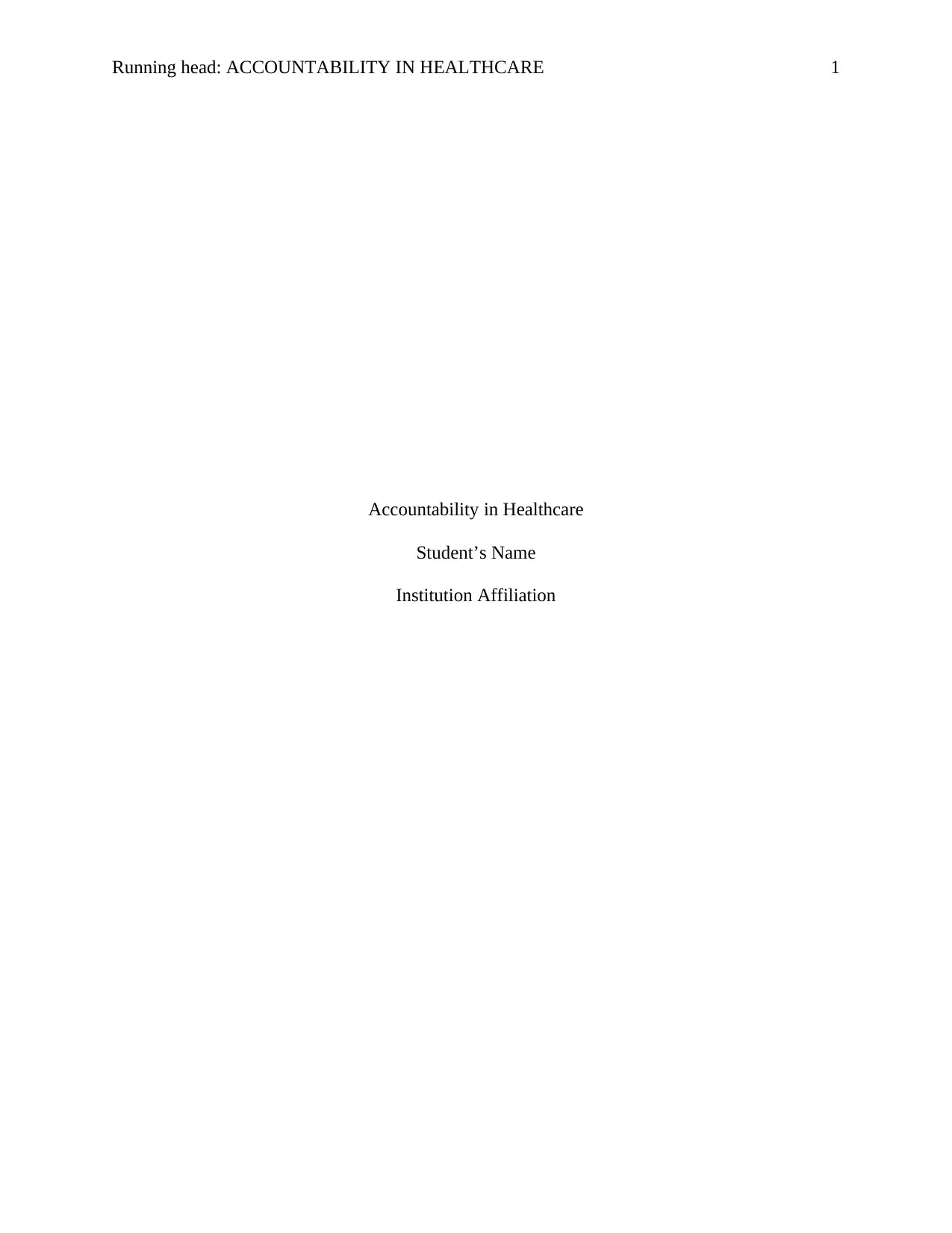
Running head: ACCOUNTABILITY IN HEALTHCARE 1
Accountability in Healthcare
Student’s Name
Institution Affiliation
Accountability in Healthcare
Student’s Name
Institution Affiliation
Paraphrase This Document
Need a fresh take? Get an instant paraphrase of this document with our AI Paraphraser
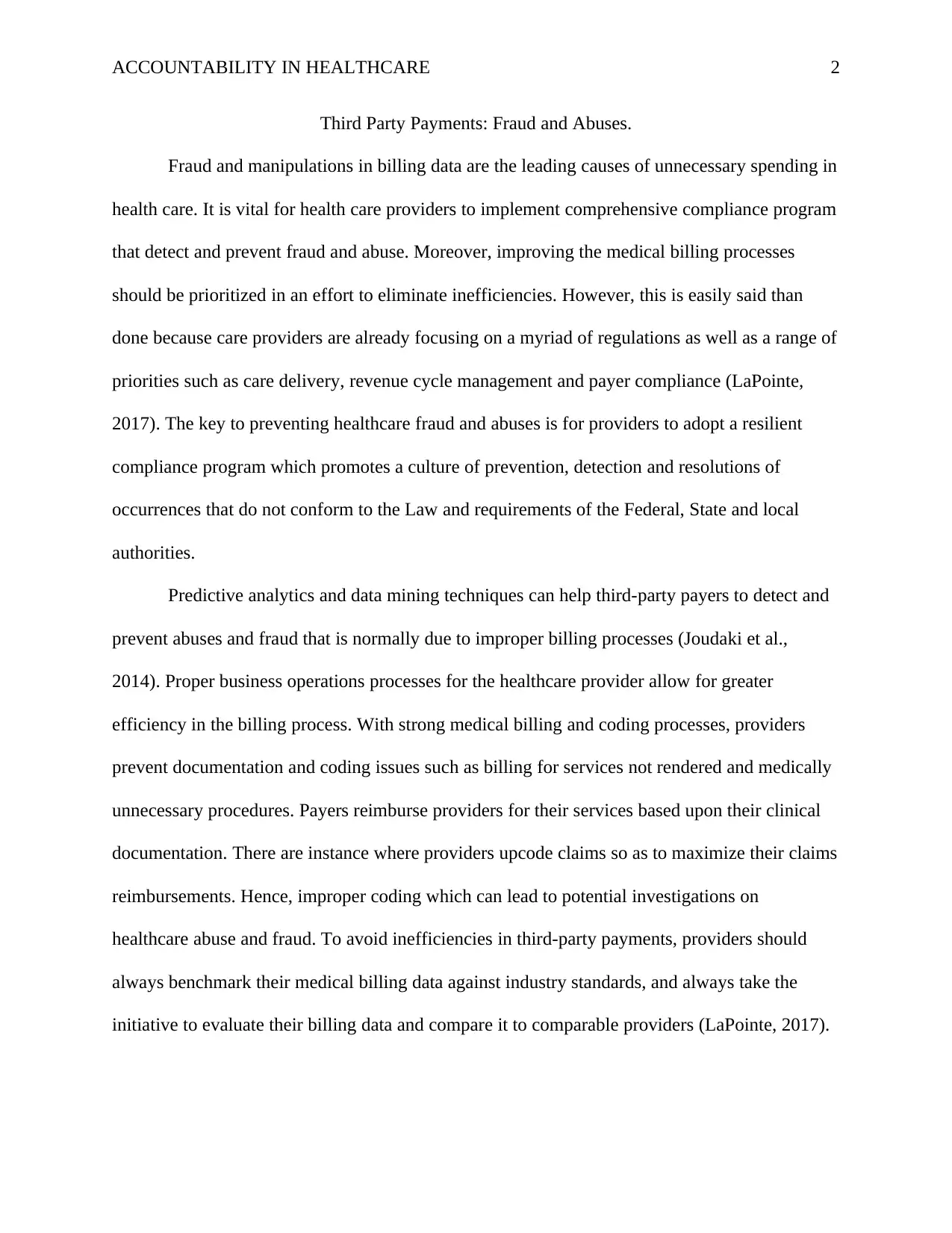
ACCOUNTABILITY IN HEALTHCARE 2
Third Party Payments: Fraud and Abuses.
Fraud and manipulations in billing data are the leading causes of unnecessary spending in
health care. It is vital for health care providers to implement comprehensive compliance program
that detect and prevent fraud and abuse. Moreover, improving the medical billing processes
should be prioritized in an effort to eliminate inefficiencies. However, this is easily said than
done because care providers are already focusing on a myriad of regulations as well as a range of
priorities such as care delivery, revenue cycle management and payer compliance (LaPointe,
2017). The key to preventing healthcare fraud and abuses is for providers to adopt a resilient
compliance program which promotes a culture of prevention, detection and resolutions of
occurrences that do not conform to the Law and requirements of the Federal, State and local
authorities.
Predictive analytics and data mining techniques can help third-party payers to detect and
prevent abuses and fraud that is normally due to improper billing processes (Joudaki et al.,
2014). Proper business operations processes for the healthcare provider allow for greater
efficiency in the billing process. With strong medical billing and coding processes, providers
prevent documentation and coding issues such as billing for services not rendered and medically
unnecessary procedures. Payers reimburse providers for their services based upon their clinical
documentation. There are instance where providers upcode claims so as to maximize their claims
reimbursements. Hence, improper coding which can lead to potential investigations on
healthcare abuse and fraud. To avoid inefficiencies in third-party payments, providers should
always benchmark their medical billing data against industry standards, and always take the
initiative to evaluate their billing data and compare it to comparable providers (LaPointe, 2017).
Third Party Payments: Fraud and Abuses.
Fraud and manipulations in billing data are the leading causes of unnecessary spending in
health care. It is vital for health care providers to implement comprehensive compliance program
that detect and prevent fraud and abuse. Moreover, improving the medical billing processes
should be prioritized in an effort to eliminate inefficiencies. However, this is easily said than
done because care providers are already focusing on a myriad of regulations as well as a range of
priorities such as care delivery, revenue cycle management and payer compliance (LaPointe,
2017). The key to preventing healthcare fraud and abuses is for providers to adopt a resilient
compliance program which promotes a culture of prevention, detection and resolutions of
occurrences that do not conform to the Law and requirements of the Federal, State and local
authorities.
Predictive analytics and data mining techniques can help third-party payers to detect and
prevent abuses and fraud that is normally due to improper billing processes (Joudaki et al.,
2014). Proper business operations processes for the healthcare provider allow for greater
efficiency in the billing process. With strong medical billing and coding processes, providers
prevent documentation and coding issues such as billing for services not rendered and medically
unnecessary procedures. Payers reimburse providers for their services based upon their clinical
documentation. There are instance where providers upcode claims so as to maximize their claims
reimbursements. Hence, improper coding which can lead to potential investigations on
healthcare abuse and fraud. To avoid inefficiencies in third-party payments, providers should
always benchmark their medical billing data against industry standards, and always take the
initiative to evaluate their billing data and compare it to comparable providers (LaPointe, 2017).
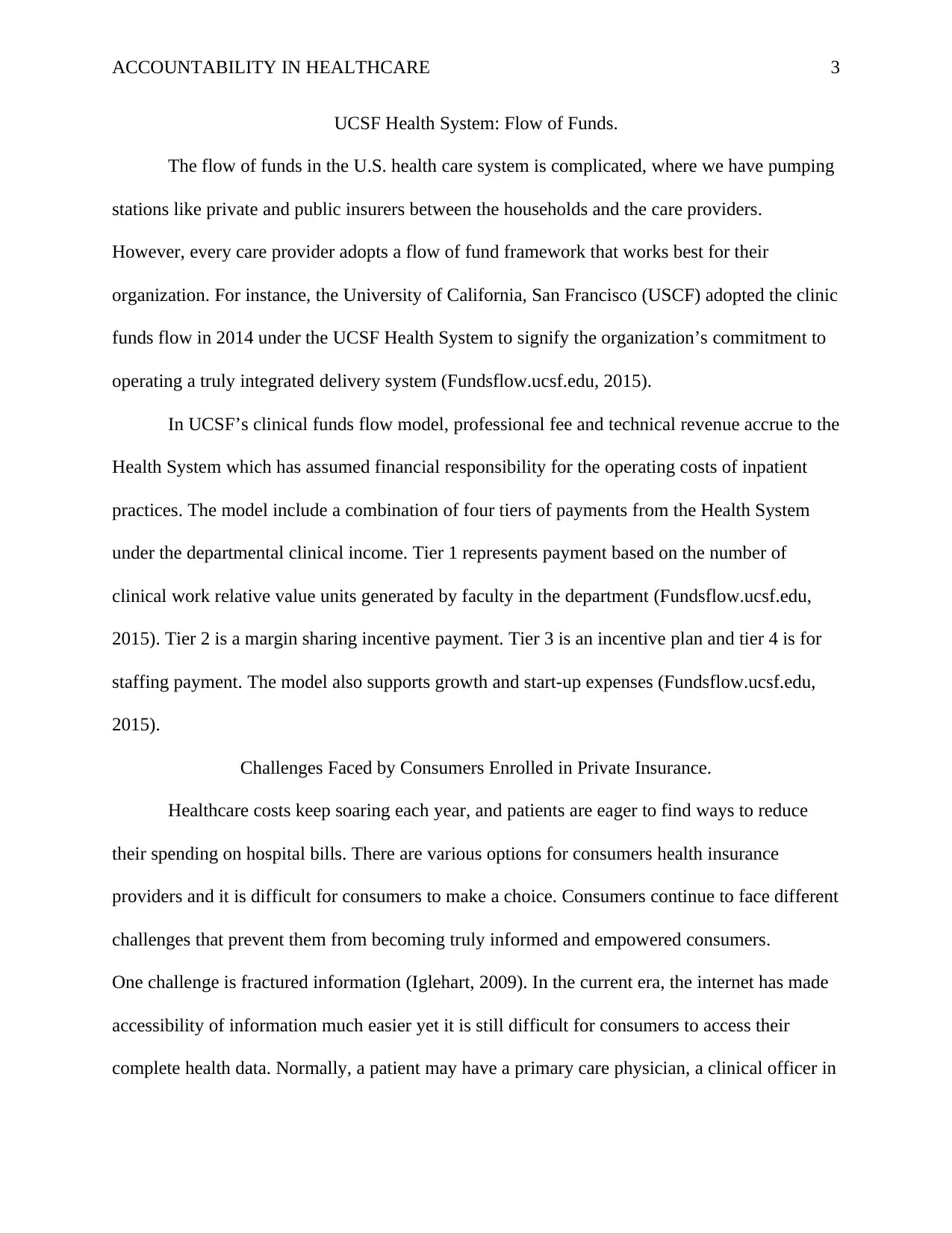
ACCOUNTABILITY IN HEALTHCARE 3
UCSF Health System: Flow of Funds.
The flow of funds in the U.S. health care system is complicated, where we have pumping
stations like private and public insurers between the households and the care providers.
However, every care provider adopts a flow of fund framework that works best for their
organization. For instance, the University of California, San Francisco (USCF) adopted the clinic
funds flow in 2014 under the UCSF Health System to signify the organization’s commitment to
operating a truly integrated delivery system (Fundsflow.ucsf.edu, 2015).
In UCSF’s clinical funds flow model, professional fee and technical revenue accrue to the
Health System which has assumed financial responsibility for the operating costs of inpatient
practices. The model include a combination of four tiers of payments from the Health System
under the departmental clinical income. Tier 1 represents payment based on the number of
clinical work relative value units generated by faculty in the department (Fundsflow.ucsf.edu,
2015). Tier 2 is a margin sharing incentive payment. Tier 3 is an incentive plan and tier 4 is for
staffing payment. The model also supports growth and start-up expenses (Fundsflow.ucsf.edu,
2015).
Challenges Faced by Consumers Enrolled in Private Insurance.
Healthcare costs keep soaring each year, and patients are eager to find ways to reduce
their spending on hospital bills. There are various options for consumers health insurance
providers and it is difficult for consumers to make a choice. Consumers continue to face different
challenges that prevent them from becoming truly informed and empowered consumers.
One challenge is fractured information (Iglehart, 2009). In the current era, the internet has made
accessibility of information much easier yet it is still difficult for consumers to access their
complete health data. Normally, a patient may have a primary care physician, a clinical officer in
UCSF Health System: Flow of Funds.
The flow of funds in the U.S. health care system is complicated, where we have pumping
stations like private and public insurers between the households and the care providers.
However, every care provider adopts a flow of fund framework that works best for their
organization. For instance, the University of California, San Francisco (USCF) adopted the clinic
funds flow in 2014 under the UCSF Health System to signify the organization’s commitment to
operating a truly integrated delivery system (Fundsflow.ucsf.edu, 2015).
In UCSF’s clinical funds flow model, professional fee and technical revenue accrue to the
Health System which has assumed financial responsibility for the operating costs of inpatient
practices. The model include a combination of four tiers of payments from the Health System
under the departmental clinical income. Tier 1 represents payment based on the number of
clinical work relative value units generated by faculty in the department (Fundsflow.ucsf.edu,
2015). Tier 2 is a margin sharing incentive payment. Tier 3 is an incentive plan and tier 4 is for
staffing payment. The model also supports growth and start-up expenses (Fundsflow.ucsf.edu,
2015).
Challenges Faced by Consumers Enrolled in Private Insurance.
Healthcare costs keep soaring each year, and patients are eager to find ways to reduce
their spending on hospital bills. There are various options for consumers health insurance
providers and it is difficult for consumers to make a choice. Consumers continue to face different
challenges that prevent them from becoming truly informed and empowered consumers.
One challenge is fractured information (Iglehart, 2009). In the current era, the internet has made
accessibility of information much easier yet it is still difficult for consumers to access their
complete health data. Normally, a patient may have a primary care physician, a clinical officer in
⊘ This is a preview!⊘
Do you want full access?
Subscribe today to unlock all pages.

Trusted by 1+ million students worldwide
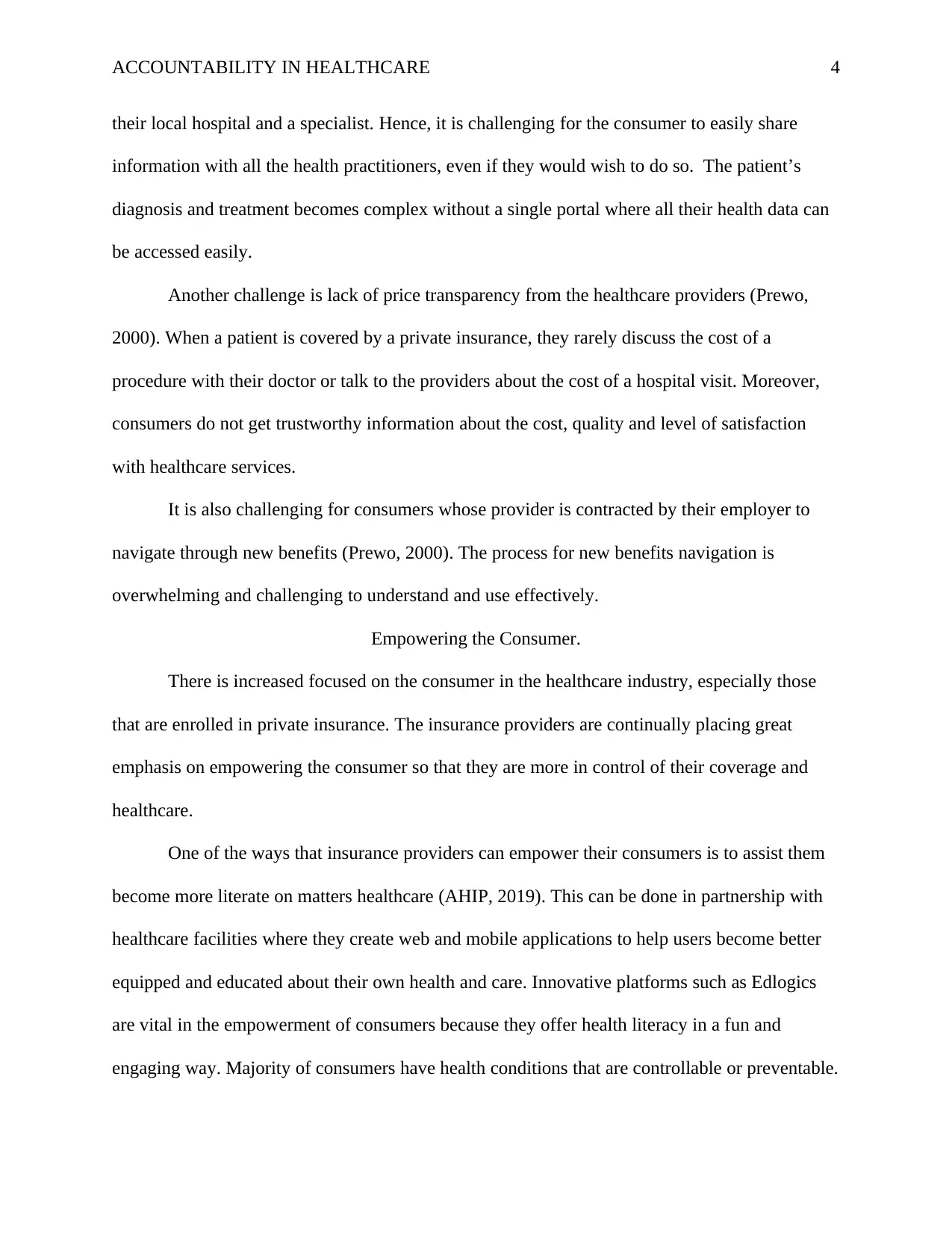
ACCOUNTABILITY IN HEALTHCARE 4
their local hospital and a specialist. Hence, it is challenging for the consumer to easily share
information with all the health practitioners, even if they would wish to do so. The patient’s
diagnosis and treatment becomes complex without a single portal where all their health data can
be accessed easily.
Another challenge is lack of price transparency from the healthcare providers (Prewo,
2000). When a patient is covered by a private insurance, they rarely discuss the cost of a
procedure with their doctor or talk to the providers about the cost of a hospital visit. Moreover,
consumers do not get trustworthy information about the cost, quality and level of satisfaction
with healthcare services.
It is also challenging for consumers whose provider is contracted by their employer to
navigate through new benefits (Prewo, 2000). The process for new benefits navigation is
overwhelming and challenging to understand and use effectively.
Empowering the Consumer.
There is increased focused on the consumer in the healthcare industry, especially those
that are enrolled in private insurance. The insurance providers are continually placing great
emphasis on empowering the consumer so that they are more in control of their coverage and
healthcare.
One of the ways that insurance providers can empower their consumers is to assist them
become more literate on matters healthcare (AHIP, 2019). This can be done in partnership with
healthcare facilities where they create web and mobile applications to help users become better
equipped and educated about their own health and care. Innovative platforms such as Edlogics
are vital in the empowerment of consumers because they offer health literacy in a fun and
engaging way. Majority of consumers have health conditions that are controllable or preventable.
their local hospital and a specialist. Hence, it is challenging for the consumer to easily share
information with all the health practitioners, even if they would wish to do so. The patient’s
diagnosis and treatment becomes complex without a single portal where all their health data can
be accessed easily.
Another challenge is lack of price transparency from the healthcare providers (Prewo,
2000). When a patient is covered by a private insurance, they rarely discuss the cost of a
procedure with their doctor or talk to the providers about the cost of a hospital visit. Moreover,
consumers do not get trustworthy information about the cost, quality and level of satisfaction
with healthcare services.
It is also challenging for consumers whose provider is contracted by their employer to
navigate through new benefits (Prewo, 2000). The process for new benefits navigation is
overwhelming and challenging to understand and use effectively.
Empowering the Consumer.
There is increased focused on the consumer in the healthcare industry, especially those
that are enrolled in private insurance. The insurance providers are continually placing great
emphasis on empowering the consumer so that they are more in control of their coverage and
healthcare.
One of the ways that insurance providers can empower their consumers is to assist them
become more literate on matters healthcare (AHIP, 2019). This can be done in partnership with
healthcare facilities where they create web and mobile applications to help users become better
equipped and educated about their own health and care. Innovative platforms such as Edlogics
are vital in the empowerment of consumers because they offer health literacy in a fun and
engaging way. Majority of consumers have health conditions that are controllable or preventable.
Paraphrase This Document
Need a fresh take? Get an instant paraphrase of this document with our AI Paraphraser
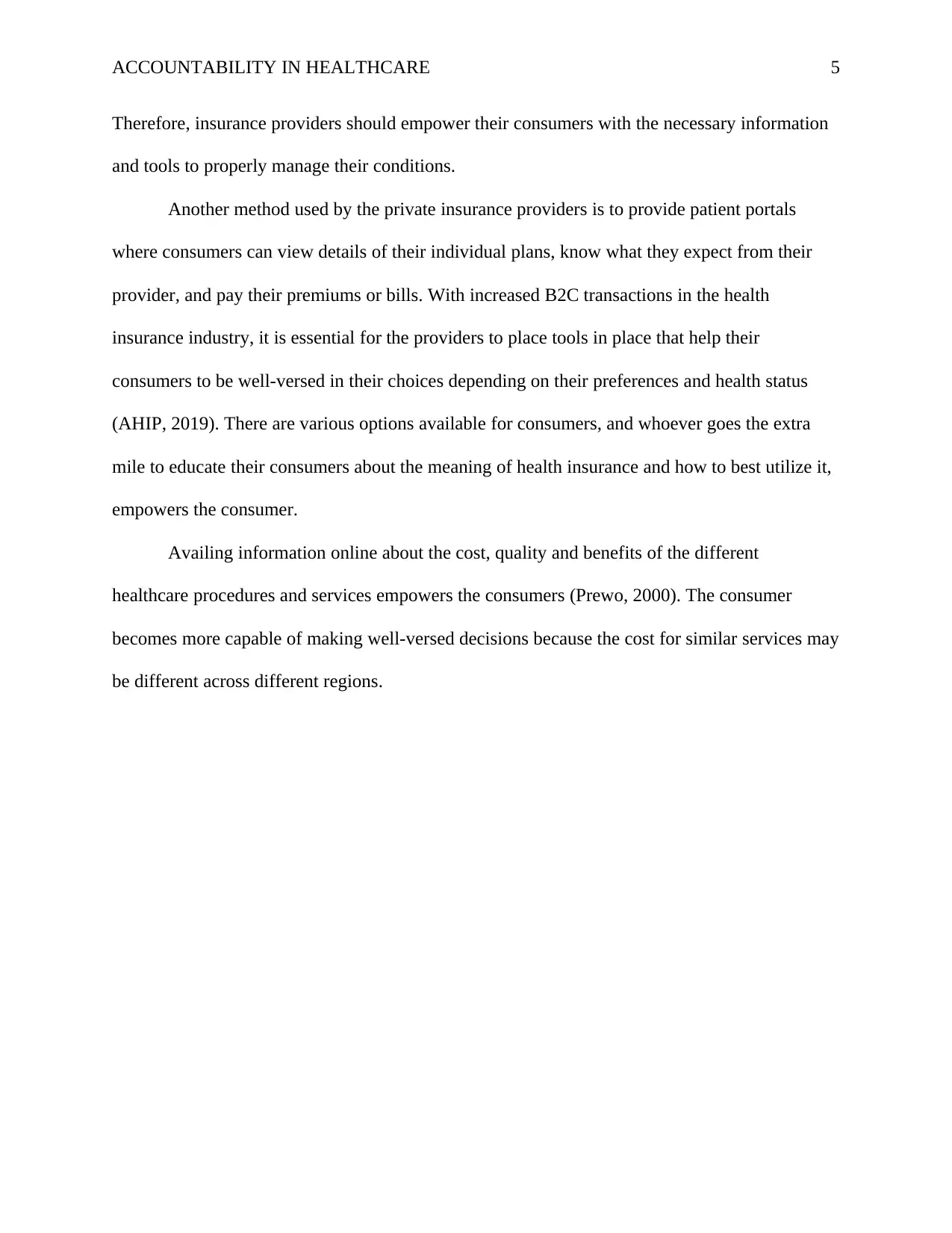
ACCOUNTABILITY IN HEALTHCARE 5
Therefore, insurance providers should empower their consumers with the necessary information
and tools to properly manage their conditions.
Another method used by the private insurance providers is to provide patient portals
where consumers can view details of their individual plans, know what they expect from their
provider, and pay their premiums or bills. With increased B2C transactions in the health
insurance industry, it is essential for the providers to place tools in place that help their
consumers to be well-versed in their choices depending on their preferences and health status
(AHIP, 2019). There are various options available for consumers, and whoever goes the extra
mile to educate their consumers about the meaning of health insurance and how to best utilize it,
empowers the consumer.
Availing information online about the cost, quality and benefits of the different
healthcare procedures and services empowers the consumers (Prewo, 2000). The consumer
becomes more capable of making well-versed decisions because the cost for similar services may
be different across different regions.
Therefore, insurance providers should empower their consumers with the necessary information
and tools to properly manage their conditions.
Another method used by the private insurance providers is to provide patient portals
where consumers can view details of their individual plans, know what they expect from their
provider, and pay their premiums or bills. With increased B2C transactions in the health
insurance industry, it is essential for the providers to place tools in place that help their
consumers to be well-versed in their choices depending on their preferences and health status
(AHIP, 2019). There are various options available for consumers, and whoever goes the extra
mile to educate their consumers about the meaning of health insurance and how to best utilize it,
empowers the consumer.
Availing information online about the cost, quality and benefits of the different
healthcare procedures and services empowers the consumers (Prewo, 2000). The consumer
becomes more capable of making well-versed decisions because the cost for similar services may
be different across different regions.
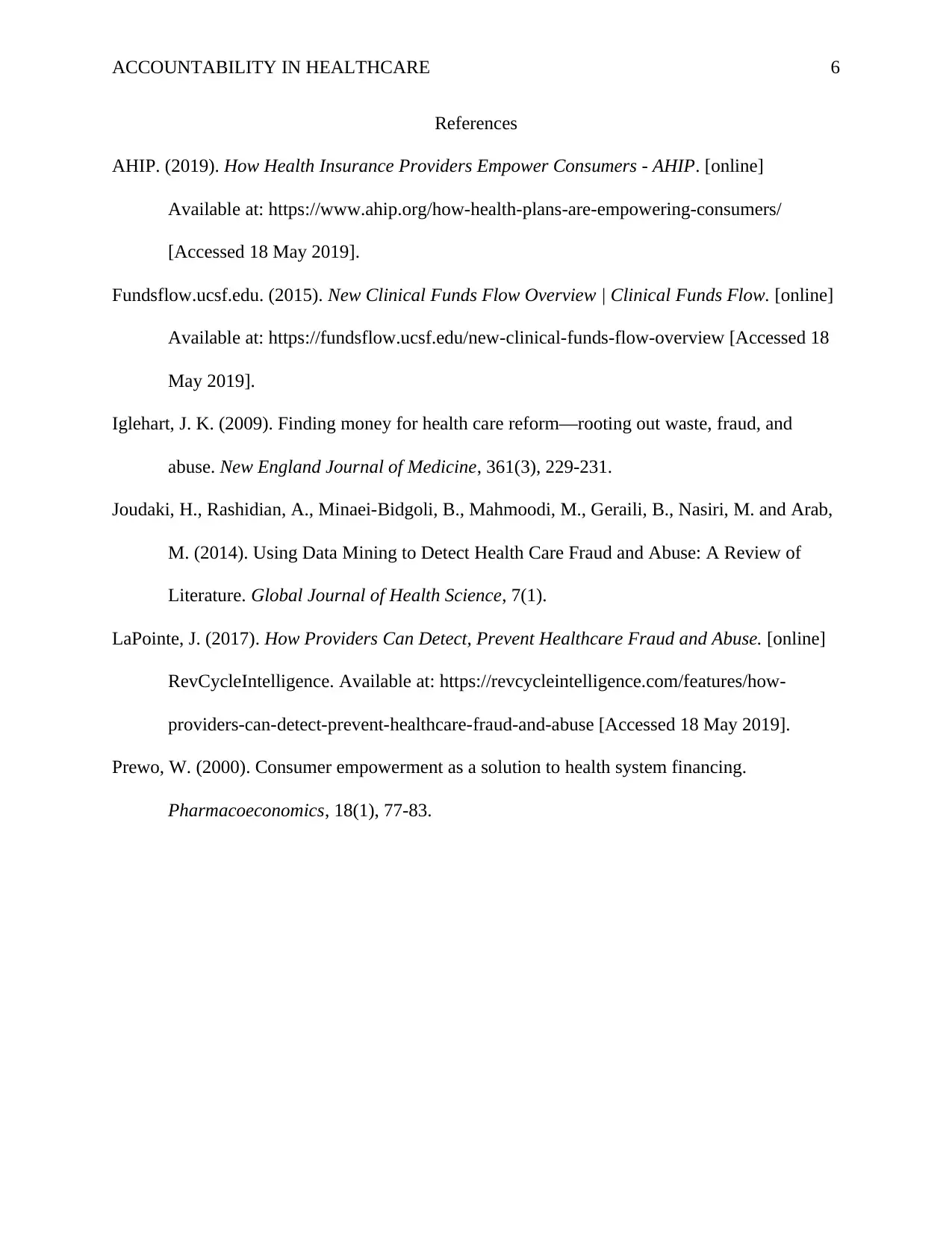
ACCOUNTABILITY IN HEALTHCARE 6
References
AHIP. (2019). How Health Insurance Providers Empower Consumers - AHIP. [online]
Available at: https://www.ahip.org/how-health-plans-are-empowering-consumers/
[Accessed 18 May 2019].
Fundsflow.ucsf.edu. (2015). New Clinical Funds Flow Overview | Clinical Funds Flow. [online]
Available at: https://fundsflow.ucsf.edu/new-clinical-funds-flow-overview [Accessed 18
May 2019].
Iglehart, J. K. (2009). Finding money for health care reform—rooting out waste, fraud, and
abuse. New England Journal of Medicine, 361(3), 229-231.
Joudaki, H., Rashidian, A., Minaei-Bidgoli, B., Mahmoodi, M., Geraili, B., Nasiri, M. and Arab,
M. (2014). Using Data Mining to Detect Health Care Fraud and Abuse: A Review of
Literature. Global Journal of Health Science, 7(1).
LaPointe, J. (2017). How Providers Can Detect, Prevent Healthcare Fraud and Abuse. [online]
RevCycleIntelligence. Available at: https://revcycleintelligence.com/features/how-
providers-can-detect-prevent-healthcare-fraud-and-abuse [Accessed 18 May 2019].
Prewo, W. (2000). Consumer empowerment as a solution to health system financing.
Pharmacoeconomics, 18(1), 77-83.
References
AHIP. (2019). How Health Insurance Providers Empower Consumers - AHIP. [online]
Available at: https://www.ahip.org/how-health-plans-are-empowering-consumers/
[Accessed 18 May 2019].
Fundsflow.ucsf.edu. (2015). New Clinical Funds Flow Overview | Clinical Funds Flow. [online]
Available at: https://fundsflow.ucsf.edu/new-clinical-funds-flow-overview [Accessed 18
May 2019].
Iglehart, J. K. (2009). Finding money for health care reform—rooting out waste, fraud, and
abuse. New England Journal of Medicine, 361(3), 229-231.
Joudaki, H., Rashidian, A., Minaei-Bidgoli, B., Mahmoodi, M., Geraili, B., Nasiri, M. and Arab,
M. (2014). Using Data Mining to Detect Health Care Fraud and Abuse: A Review of
Literature. Global Journal of Health Science, 7(1).
LaPointe, J. (2017). How Providers Can Detect, Prevent Healthcare Fraud and Abuse. [online]
RevCycleIntelligence. Available at: https://revcycleintelligence.com/features/how-
providers-can-detect-prevent-healthcare-fraud-and-abuse [Accessed 18 May 2019].
Prewo, W. (2000). Consumer empowerment as a solution to health system financing.
Pharmacoeconomics, 18(1), 77-83.
⊘ This is a preview!⊘
Do you want full access?
Subscribe today to unlock all pages.

Trusted by 1+ million students worldwide
1 out of 6
Related Documents
Your All-in-One AI-Powered Toolkit for Academic Success.
+13062052269
info@desklib.com
Available 24*7 on WhatsApp / Email
![[object Object]](/_next/static/media/star-bottom.7253800d.svg)
Unlock your academic potential
Copyright © 2020–2025 A2Z Services. All Rights Reserved. Developed and managed by ZUCOL.





